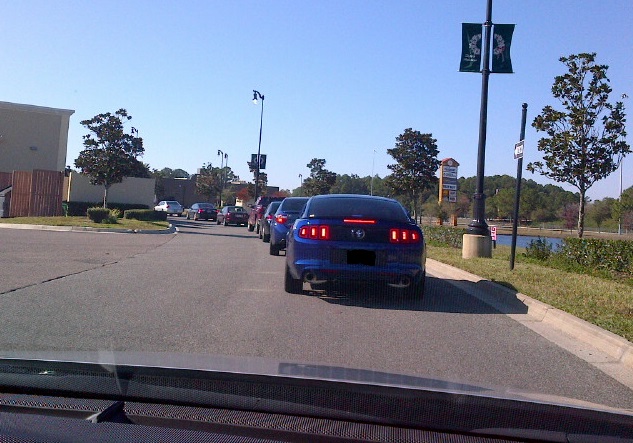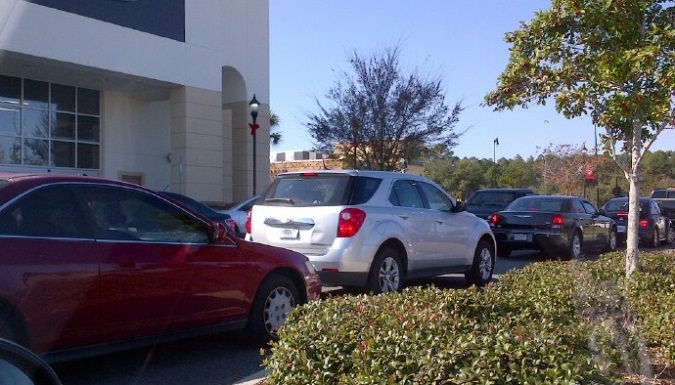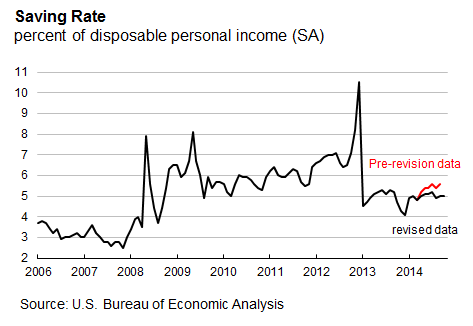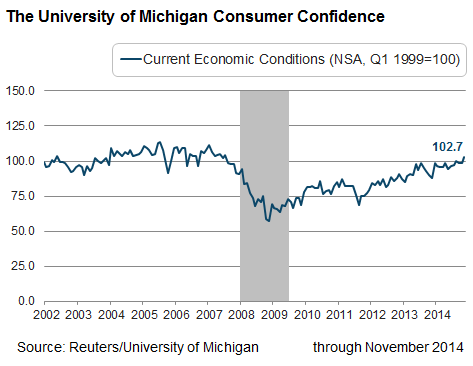BLACK FRIDAY! Black Friday has historically been the day that retailers wait for all year long. It's the day when merchants hope to move from the red to the black column (hence the name). However, I as a consumer have often avoided going to the stores on this infamous day for two reasons: one, big crowds give me the heebie-jeebies, and two, I am usually working the day after Thanksgiving—doing regional economic analysis but also preparing the Jacksonville Branch for the upcoming holiday season.
As I sit here penning this post, I am steeling myself for what lies ahead: I have to brave the crowds today, Black Friday 2014, to purchase a few last-minute items to complete the holiday transformation of the branch. When I decided to go on this shopping trip with my colleague, Barb, neither of us realized what kind of day it would be...goodness, what were we thinking?!
So, we put on our armor and headed out into the madness. Here are a few pictures I took of what we encountered just trying to get to the store and find a parking space.

Taking the back way into the shopping center. Apparently, everyone thought no one else would try it.
Parking lot gridlock
Well, I'm happy to report that Barb and I survived our shopping excursion! But I'm also delighted to discuss the survival of retailers, since a successful Black Friday is vital to the retail industry. According to the National Retail Federation's (NRF) Thanksgiving Weekend Expectations survey, approximately 140 million shoppers were likely to take advantage of deals during the Thanksgiving weekend. Of this number, 67.6 million shoppers said they would actually shop, and 72.5 million would take a wait-and-see attitude to judge whether the deals offered were worth the trip to the stores. The NRF also noted that merchants would have to come up with amazing deals to induce consumers to spend, given that retail has been so heavily discounted since the start of the recession.
So what was the condition of the consumer going into this past holiday weekend? According to third quarter results from the New York Fed's Report on Household Debt and Credit, household debt and mortgage balances were up and credit for auto loans and credit cards increased, all pointing to more freely spending households.
Personal savings rate data from October represent further evidence that the consumer is willing to spend. According to the U.S. Bureau of Economic Analysis, the personal savings rate is personal saving (disposable personal income less personal outlays) as a percentage of disposable personal income. Prior to the release of October data, the savings rate appeared to show people saving more. However, revised data indicate that the savings rate has remained about the same since the beginning of the year, September's rate was revised down from 5.6 percent to 5.0 percent (see the chart). It would appear that people are not saving as much as previously thought, which bodes well for retailers.

We have heard from some District contacts that the lower gasoline prices have freed up some discretionary dollars, with consumers taking advantage of the extra cash in their pockets, which benefits retailers. Although the consumer seems to be well positioned to spend, how they feel matters as well. We can gauge this by looking at consumer confidence measures such as the Conference Board's present situation survey and the University of Michigan's current economic conditions survey. However, these surveys represent different points of view. The Conference Board is interested in the consumer's opinion of overall economic conditions as they relate to businesses and jobs, and the University of Michigan focuses its attention on the individual's current condition as it relates to his or her household. For the purpose of this post, let's examine the individual consumer's stance on current conditions. The University of Michigan's current economic conditions index rose from 98.3 points in October to 102.7 in November, the highest it's been since July 2007 (see the chart). It appears that the consumer is feeling pretty good these days.

So how does all this suggest consumers' greater willingness to spend? Let's look at it this way: Personal debt is rising; people are saving less; people are spending; and retail sales are (hopefully) up.
Now that Black Friday has come and gone, the NRF has released its preliminary results, which show the number of shoppers dropped this year. Given that Black Friday still draws the biggest crowds of the Thanksgiving weekend—and the weekend also includes Small Business Saturday and Cyber Monday—it should be interesting to see what the retail sales data (released on January 14, 2015) say about the success of the holiday weekend.
Until then, Season's Greetings, everyone—and happy shopping!
 By Christine Viets, a senior Regional Economic Information Network analyst in the Jacksonville Branch of the Atlanta Fed
By Christine Viets, a senior Regional Economic Information Network analyst in the Jacksonville Branch of the Atlanta Fed



